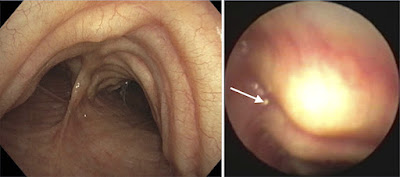EBUS Procedure: A Modern Approach to Lung Diagnosis
INTRODUCTION
Endobronchial Ultrasound (EBUS) is a minimally invasive procedure used by pulmonologists to diagnose pulmonary conditions such as lung cancer, infections, and other mediastinum-related medical conditions. EBUS has changed the way healthcare professionals approach lung and lymph node biopsies by combining real-time imaging and tissue sampling. This guide provides a clear brief explanation of the EBUS procedure, applications, and advantages.
 |
Endobronchial ultrasound (EBUS) scope advances. (a) Hybrid EBUS (H-EBUS) scope demonstrating augmented flexibility and the more acute viewing angle. Images adapted with permission from AME publishing company. (b) Size comparison of the standard EBUS scope (bottom) with the thin convex probe EBUS scope (top).
WHAT IS EBUS?
EBUS is a modern diagnostic procedure that use ultrasound technology through a bronchoscope to see structures in and around the airways. EBUS, unlike standard bronchoscopy, uses ultrasound to produce real-time images of tissues, making it especially useful for examining lymph nodes and tumors near the lungs and airways.
KEY FEATURES
INDICATIONS OF EBUS
EBUS is commonly recommended for:
- Lung Cancer Staging: Determining the extent of lung cancer spread.
- Diagnosing Infections: Identifying infections like tuberculosis or fungal diseases.
- Evaluating Sarcoidosis: Confirming granulomas or other abnormalities.
- Assessing Mediastinal Masses: Investigating unexplained enlargements or tumors.
THE EBUS PROCEDURE
The EBUS procedure is typically performed as an outpatient service and involves the following steps:
1. Preparation:
- Pre-Procedure Testing: Patients may undergo imaging tests like CT or PET scans to guide the procedure.
- Fasting: Patients are instructed to fast for 6-8 hours before the procedure.
- Sedation: Conscious sedation or general anesthesia is administered to ensure patient comfort.
2. During the Procedure:
- Insertion of the Bronchoscope: A flexible bronchoscope with an ultrasound probe is inserted through the mouth or nose.
- Ultrasound Imaging: The probe emits sound waves to visualize structures and detect abnormalities.
- Fine-Needle Aspiration (FNA): Under ultrasound guidance, a thin needle is passed through the bronchoscope to collect tissue or fluid samples.
3. Post-Procedure Care:
- Patients are monitored for a few hours for potential side effects, such as a sore throat or mild coughing.
- Normal activities can usually be resumed within a day.
ADVANTAGE OF EBUS
Although EBUS is generally safe, some risks include:
- Minor bleeding at the biopsy site.
- Temporary sore throat or coughing.
- Rare complications, such as infection or pneumothorax (collapsed lung).
EBUS may also have limitations in accessing certain deeply located or small lymph nodes, requiring alternative diagnostic methods.
RECOVERY AND RESULTS
CONCLUSION
Endobronchial Ultrasound (EBUS) is a revolutionary tool in respiratory medicine, offering a safe, accurate, and less invasive alternative for diagnosing lung and mediastinal conditions. As healthcare continues to embrace minimally invasive technologies, EBUS stands out as a pivotal advancement in patient care.





.jpeg)

No comments:
Post a Comment